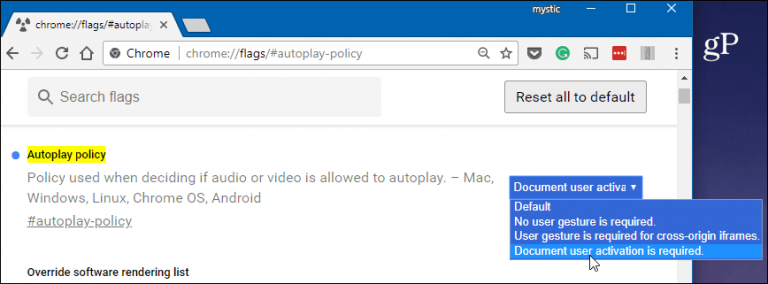
You can continue to listen to Nyan Cat on loops on YouTube while browsing the Wikipedia entry for Groot.Īll that’s being ‘halted’ here is the ability for tabs to automatically play content in the background. This doesn’t affect the ability to play video in the backgroundīefore you panic this feature does not remove the ability to play videos in background tabs. Because plugins won’t need to start rendering media until you’ve given it the okay Chrome will, in theory, sup on a little less battery juice than before. This feature may, potentially, improve Chrome’s power usage too. For example, if you middle click a YouTube video it won’t play right away but Chrome will begin loading it so as to avoid buffering. Video content loaded in a background tab will no longer play automatically until you visit the tab.Ĭhrome will continue to load media content in the background.
#Chrome autoplay video setting mac
The latest dev channel release of Google Chrome for Windows, Mac & Linux solves these issues. Chrome will pause videos, ads and other auto-play media content until you’re ready. It’s annoying because most of the time you don’t know these media elements are there (much less about to blast out of your speakers) or if you do know they’re there, you want them to ‘wait’ to play until you’re ready to watch (otherwise you wouldn’t be opening it in a background tab). These annoying sound blast are the result of media elements starting to play as soon as a web-page loads. Now, in the latest developer channel release of Chrome, Google is going one step further. There’s a nifty tab indicator to find a noisy web-page quickly and a mute button to make it shuttity-up -up-up. Recent versions of Chrome ship with features designed to tame this annoyance. The sudden jolt of panic caused by a background tab playing a video unexpectedly… Yeah, it’s something most of us are familiar with. Rebooting the Reef: CNET dives deep into how tech can help save Australia's Great Barrier Reef.Unexpected audio blasts can be super annoying
#Chrome autoplay video setting software
The Brave browser blocks all ads and web software that tracks your online behavior, and Firefox has made it easier to block trackers, too.ĬNET Magazine: Check out a sample of the stories in CNET's newsstand edition. Last year, Apple's Safari started blocking most autoplay videos if they used sound. This year, Chrome also began blocking ads on some websites if Google judges the sites to be using too many. There are several other examples of browsers stepping in on behalf of users. The result is a web that should be less annoying - but also one where advertising-funded sites have a harder time with their businesses. The autoplay blocking is an example of how browsers are getting more assertive on behalf of users faced with pushy websites. "As you teach Chrome, you may find that you need to click 'play' every now and then, but overall the new policy blocks about half of unwanted autoplays, so you will have fewer surprises and less unwanted noise when you first arrive at a website," John Pallett, a Chrome product manager, said in a blog post. Then, as you browse the web, Chrome updates that list as it learns where you play media and where you don't.

But the browser doesn't always block autoplay, and on Thursday, Google detailed how Chrome learns which sites to squelch.Ĭhrome begins with a list of more than a thousand sites where Google found that the browser's users typically played audio or video with sound. When Google released Chrome 66 in April, it clamped down on lots of websites that tried to play video and audio automatically.


 0 kommentar(er)
0 kommentar(er)
